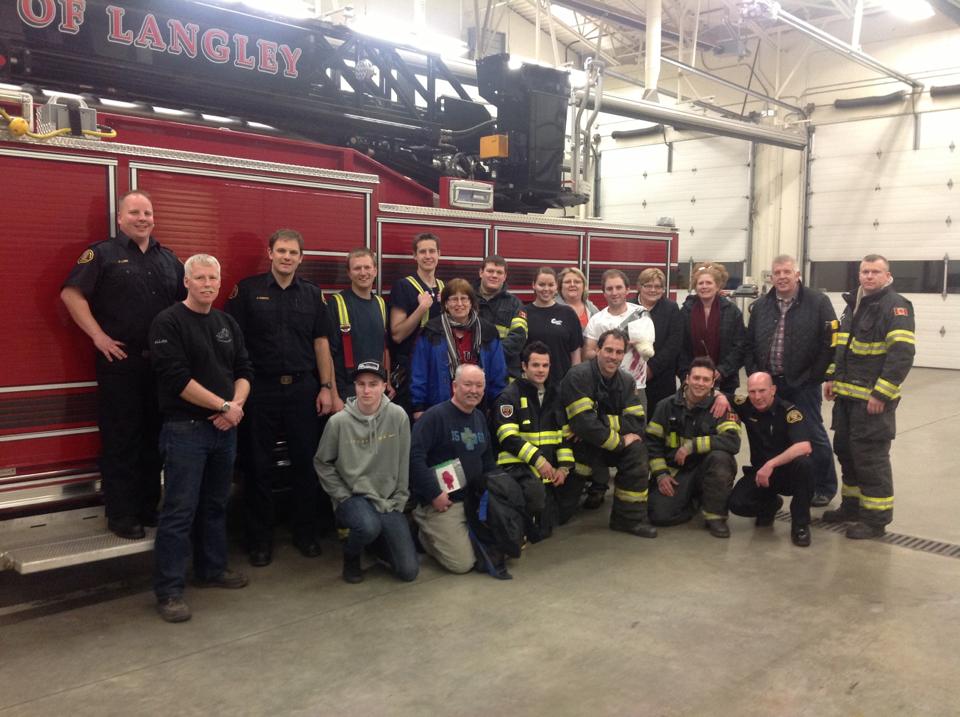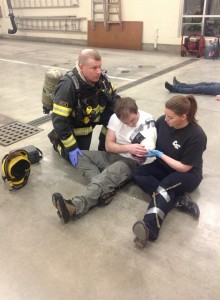By Jeremy Hannaford (The Cascade) – Email
Print Edition: March 26, 2014

It’s a casual scene, as people fill a firehall, waiting for something to happen. A smoke machine begins to fill up the hall. Some people have broken sticks taped to their legs; one woman has been “impaled” by them. One has his arm in a garbage bag and is covered with red corn syrup while another person feigns deafness and shellshock. Silence falls upon the hall as a fire truck pulls up and firefighters run in with gas monitors and medical equipment. This is merely an exercise, but it’s something these men must be prepared for when a real emergency happens.
All this took place on March 18 at the Aldergrove Fire Hall. Firefighters Ian Darvill and Ryan Olseka welcomed all the volunteers. Many were community members or relatives of the firefighters. There were a few who were even looking into firefighting as a career.
Ian and Ryan then explained the scenario we were taking part in. The exercise was called a mass casualty scenario, in which everyone acts out different conditions of distress. Those who had broken sticks taped on had broken bones. I was acting out someone with a missing arm, with a garbage bag acting as a makeshift cover. Ian said the situation was to resemble what emergency personnel faced at the Boston Marathon bombings.
When the fire truck rolled up, the firefighters lined up outside the hall. Instead of rushing in all at once, two walked in slowly, holding up a small monitoring device. This tool is called a four gas monitor, which evaluates the quality of air in the area. This determines for the firemen whether the air is safe to breathe without assisted oxygen.
The captain on duty then announced to anyone who could move under their own power to move towards them so they could be properly assessed. After that, the firemen searched through the casualties. They moved from person to person, performing a quick assessment of the condition everyone was in using the MIDD system: moderate, immediate, delay, and death. In a situation as chaotic as ours, these firemen would need to quickly decide which people were in more need of immediate medical attention. Since I was missing my arm, I was cared for immediately rather than my girlfriend, who had a broken leg.
Jhim was the name of the firefighter who attended to my wounds. He first checked my pulse and my level of consciousness through conversation. He asked my girlfriend about the seriousness of my condition as she held a makeshift bandage. Jhim then applied gauze fabric to my arm and pinned it together before sending me to the ambulance with the other victims. Throughout this entire event, Ian and Ryan recorded the actions of the firemen so the footage could be viewed later for analyzing procedures and assessments.

After the exercise was finished, all the firemen lined up for breakdown. They reported their actions and procedures, and the fire chief then commented on their actions and any improvements they could have made. Overall, the exercise went very well. Each firefighter had properly attended to their wounded person and carried out the right medical procedures. We volunteers were also given tips on administering medical aid. I learned that using a belt would be a last measure in the situation of a missing limb. Applied pressure or bandages are preferable as a belt leads to stopping blood flow. That would lead to gangrene and possible infection.
While at the time it felt silly to have an arm wrapped up in a garbage bag, the situation was deadly serious. These training exercises help prepare firefighters for the severity of the situation. They have the procedures memorized and can execute them efficiently without distress. These firefighters were a great bunch of guys who all carry humble hearts but were serious and professional during the exercise.
Similar events are performed at other fire halls throughout the Fraser Valley. These can be great insights into what firefighters go through, as well as a possible door-opener for those who wish to join their ranks. There are also the emergency response team role play scenarios hosted by the Abbotsford Police Department. You can find out more about those events and how to sign up from UFV criminology professor Al Gray.

